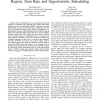Free Online Productivity Tools
i2Speak
i2Symbol
i2OCR
iTex2Img
iWeb2Print
iWeb2Shot
i2Type
iPdf2Split
iPdf2Merge
i2Bopomofo
i2Arabic
i2Style
i2Image
i2PDF
iLatex2Rtf
Sci2ools
ICC
2008
IEEE
2008
IEEE
Network Coding for Two-Way Relaying: Rate Region, Sum Rate and Opportunistic Scheduling
—Network coding for two-way relaying in a three-node network is considered. The achievable rate regions under both traditional four-slot multi-hopping (FSMH) and network coding (MAC-XOR) are characterized, showing a combination between the two is needed for a larger region. This is accomplished by an opportunistic network coding scheduling which requires minimal information. Queuing analysis shows that for any pair of random Poisson arrivals with rates within the convex hull of FSMH and MAC-XOR regions is stabilizable. Next we consider how traffic pattern, described by the rate ratio between uplink and downlink, influences the sum rate. It is analyzed and compared with that of FSMH. It is shown that network coding achieves the maximum gain when traffic is symmetric, while it could be worse than FSMH when the traffic is very asymmetric. How multiple antennas influence the performance of network coding is also discussed. Finally, simulations based on Erceg fading model under a WiM...
| Added | 30 May 2010 |
| Updated | 30 May 2010 |
| Type | Conference |
| Year | 2008 |
| Where | ICC |
| Authors | Chun-Hung Liu, Feng Xue |
Comments (0)

